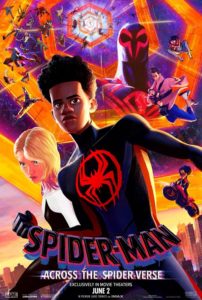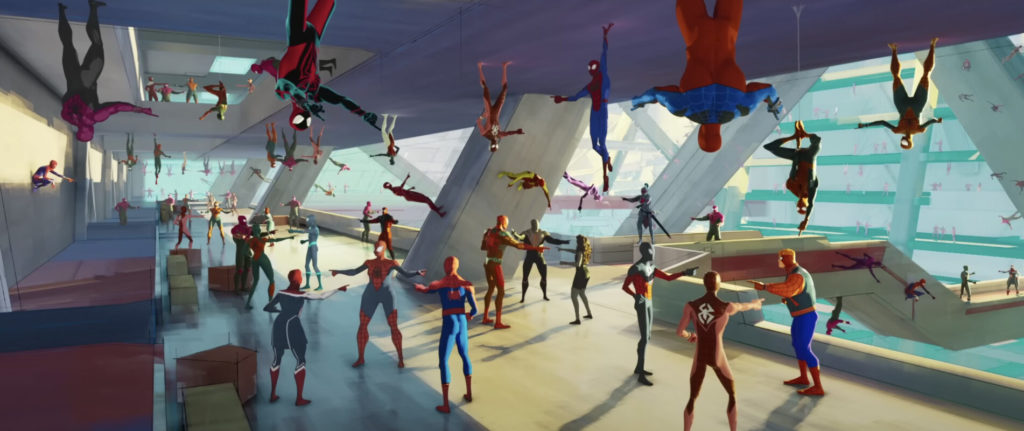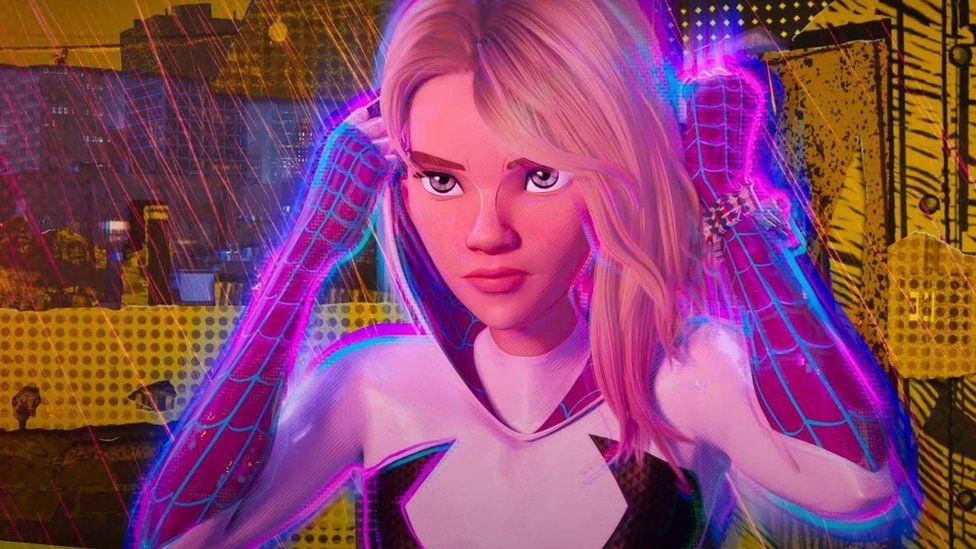They Tumble Blindly as they make their way Across the Spider-Verse
DIRECTED BY JOAQUIM DOS SANTOS, KEMP POWERS, AND JUSTIN K. THOMPSON/2023

Somewhere between exhilaration and exhaustion is… the Spider-Verse!
This may be a moderately unpopular opinion, but the long-awaited sequel (the first of at least two, this film being “to be continued!” next year in Beyond the Spider-Verse) is not as good as its beloved predecessor, 2018’s Spider-Man: Into the Spider-Verse. That film, with its radical animation and non-Peter Parker Spider-Man, deservedly blew minds upon impact and quickly became one of the defining films of its generation. It’s an honest challenge to find someone who truly dislikes that movie.
Naturally, home studio Sony and creators Phil Lord and Christopher Miller lunged into action preparing the inevitable follow-ups. But these things take time, particularly when you’re dealing with complex animation stylings that are absolutely revolutionary in the eyes of mainstream audiences. And so, nearly five years and one global pandemic later, we return to the brain-expanding world of the Spider-Verse.
The first result, the 140-minute Across the Spider-Verse, is a lot. As in, A LOT a lot. As helmed by first time feature directors Joaquim Dos Santos, Kemp Powers, and Justin K. Thompson, the film resembles the intentional overreaching/overstuffed ambitions of The Matrix Reloaded (2003) and Pirates of the Caribbean: Dead Man’s Chest (2006). Both of those examples are clamored-for sequels to fun and extremely popular free-standing original films. Also, both opted to springboard their franchises into sheer largesse. What began with an organic zeitgeist-flaring success snowballed into bigger-budgeted reverse-engineered 500-pound weight mythologies. That despite they’re only parts one of two pre-planned, pre-packaged, increasingly self-serious high-stakes follow-ups. As tentpoles, both crack under the pressure to please and to be more. The basic appeal of said originals can’t resist the tide of contemporary Hollywood inevitably: “Love the first one? Here’s at least two more, quadruple-sized and directorially untethered!!” It’s everything everyone dug about the first film, amplified… except for that nonreplicable spark of the new. There is, though, a lot more resources to compensate with. But still… the heft…

Across the Spider-Verse is far, far better than the sequels to The Matrix and Pirates of the Caribbean: Curse of the Black Pearl. Still, by virtue of its monetary pop culture perch, it can’t help but exhibit the same basic shortcomings. On one hand, it’s a bombastic burst of unrelenting mumbo jumbo. On the other, it’s the most spectacular visual blast you’ve ever beheld. Aesthetic! Aesthetic!! AESTHETIC!!!!
In the first twenty minutes alone, as our hero takes on a deceptively formidable new physics-defying villain called The Spot (Jason Schwartzman), the film clobbers viewers sensibilities with the most colorful most contorting most dynamic most rapid most amped-up and thumping-loud renderings ever put forth at the movies. Everything is just too frenetic to leisurely keep track of. (These filmmakers could take a lesson or two on action staging from George Miller). Be prepared to work.
The voice of Miles Morales/Spider-Man, Shameik Moore returns along with much of Into’s supporting cast. (Brian Tyree Henry as Miles’ father, Luna Lauren Vélez as Miles’ mother, Jake Johnson as Peter B. Parker, etc.) That film’s surplus population of Spider-Men (a total six, if I recall correctly) has nothing on this film’s arachnid roll call. (Spider-Hero voices include Issa Rae as a pregnant Jessica Drew/Spider-Woman; Karan Soni as Spider-Man India; Daniel Kaluuya as the very fun “Spider-Punk”; Amandla Sternberg as Spider-Byte; and Andy Samberg as Scarlet Spider. There’s more…).

Infinite Spider-People variations from infinite Earths across infinite everythings congregate in a massive high-tech cosmic clubhouse run by the suspiciously humorless Spidey of the year 2099, Miguel O’Hara (Oscar Isaac). Miles finds his way into this headquarters when he follows the gal-pal he’s been pining for since the first movie, the white caped Spider-Woman (aka Spider-Gwen, voiced again by Hailee Steinfeld), into the fold. Not welcome by Miguel for reasons that slowly become semi-clear, Miles is given a “day pass” to prevent him from glitching away, and told that he needs to get back where he came from. But when a Spider-Man is this far from home, there might just be no way home.
What really comes through here are the central themes of holding true to one’s own identity and values, even in the face of a bizarrely shifting world. (Especially in the face of a bizarrely shifting world). The action is considerably ratcheted up, but then so are the talky lulls. You see, there are “canon events” that impact the lives of every Spider-Man in every separate universe/dimension/publishing endeavor/rehash/reboot/reimagining. The Uncle Ben figure must always die. The same is true for the Gwen Stacy figure. He’ll be called a hero, he’ll be called a menace. With the same great power always comes the same great responsibility. But when all six-zillion trillion gazillion Spider-Men are all in on making sure everything always works out that way, what the heck does “great responsibility” then look like?? It’s no spoiler to say that Miles isn’t having it.

Maybe I’m just multiversed-out. Yet, as cumbersome as these cross-dimensional yarns are, who can blame today’s storytellers for latching onto the metaphor? In a real world that’s been overtaken by subjective realities ever narrowed by algorithms and blaring political hokum, it just makes sense. Simply saving the Earth doesn’t cut it anymore; now it’s the entire fabric of “the multiverse” that’s continually at stake. Our own planet may be doomed, but maybe there’s still time to gather the threads of our collective worlds, unifying what we can. Those opposed to any such unification are and will always be the villains. Miguel O’Hara knows how this story is supposed to go, and nothing’s gonna change his world.
To really cross universes with a metaphor, maybe the pre-bundled sequelness of it all won’t in fact be red kryptonite for this series. Maybe the increased weight and stakes of Across the Spider-Verse will be more like another other franchise that ran with the back-to-back sequels model, Back to the Future. Back to the Future, Part II (1989) definitely got dark and deep in its own weeds. But then the next movie was a really fun Western! And hey, as of this film, the Spider-Verse has its own Cowboy Webslinger! To run with Across the Spider-Verse’s own thwipped-out wild logic, the Spider-Possibilities could actually be endless, inciting and inviting.


